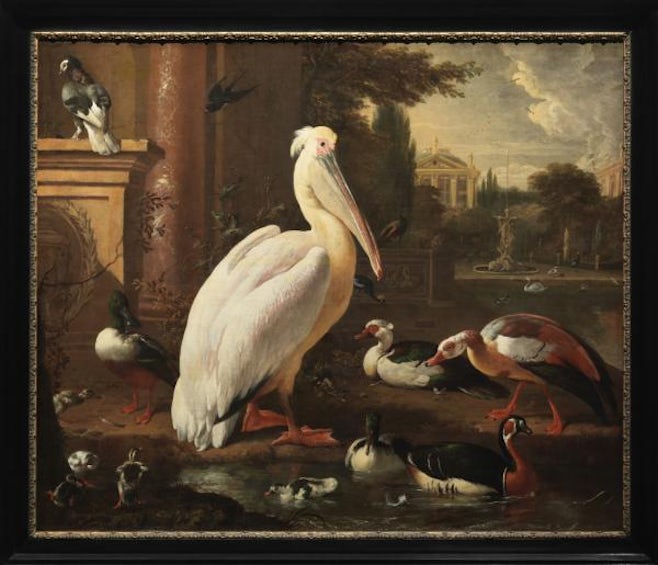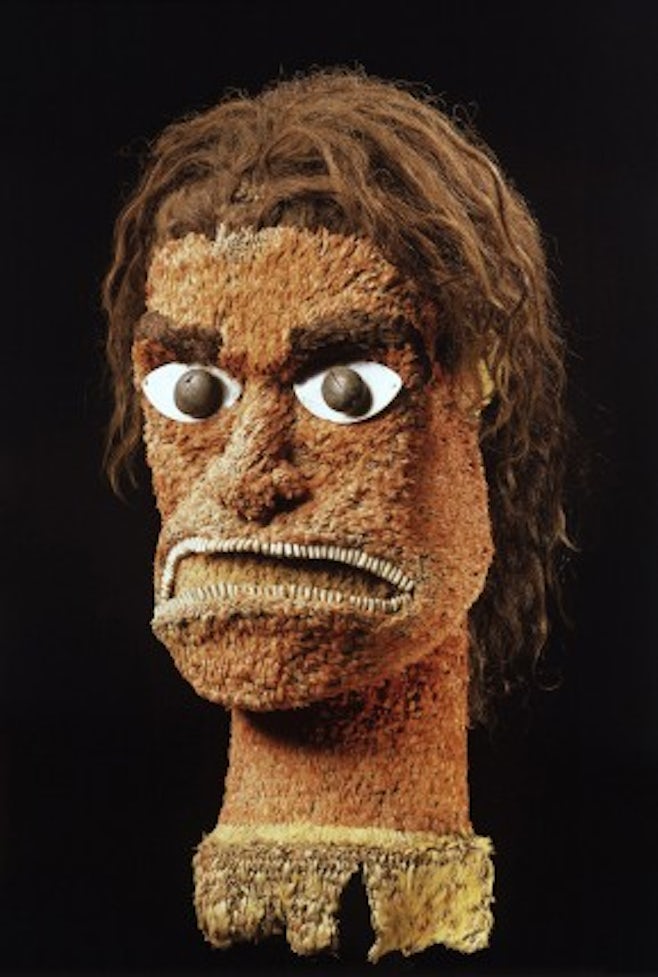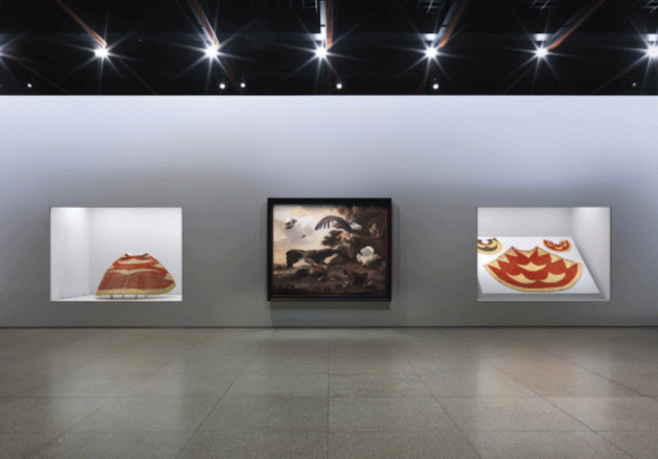
If the basement of Berlin’s iconic Neue Nationalgalerie is currently home to a (marvellous) display of works from the museum’s permanent collection that has been titled ‘Modern Times’, how do we identify the time evoked in the temporary exhibition now on view on the ground floor, Dutch artist Willem de Rooij’s magnificent ‘solo’ project ‘Intolerance’? Timeless, perhaps: that certainly, and somewhat paradoxically, seems to be an apt description of the effect produced by de Rooij’s idiosyncratic, tightly choreographed juxtaposition of two families of object that, at first sight, do not seem to have terribly much in common: animal portraits from the Golden Age of Dutch painting on the one hand, and feathered ceremonial objects from eighteenth-century Hawaii on the other hand. De Rooij’s richly layered three-dimensional collage is the subject of the following conversation, conducted in the artist’s apartment in Berlin shortly after the exhibition opened in September 2010.
DIETER ROELSTRAETE: I know that this show has been a long time in the making. Perhaps you can tell us a bit more about its genealogy. What was the basic impulse behind this unorthodox juxtaposition of seventeenth-century Dutch genre painting and feathered ceremonial objects from eighteenth-century Hawaii?
WILLEM DE ROOIJ: I’ve been interested in the work of Melchior d’Hondecoeter for a long time. I used reproductions of his paintings on several occasions since I started incorporating works by other artists in my installations – or spatial collages – in 2006. In this context, the paintings by d’Hondecoeter functioned as emblems of sorts: I used his imagery on invitation cards, so that on a conceptual level they operated as some kind of summation. Even though my interest in his work was always there, I could never find much information on it, so producing text on his work became an important part of the development of ‘Intolerance’. Another important decision was to install the actual paintings and the actual feathered objects – rather than reproductions, since I did not want to talk about reproductions or the act of reproducing in the installation. The book, of course, contains tons of reproductions.
DR: As for the relative dearth of information regarding d’Hondecoeter, his work is something of an acquired taste – the kind of painting that is easily overlooked.
WdR: But I grew up looking at his work; he is well known in the Netherlands. Some of his most important works are in the Rijksmuseum in Amsterdam, where I first got to see them. It’s interesting how one develops a kind of tunnel vision growing up in the Netherlands, looking at Dutch painting primarily. Someone who grows up in, say, London or Paris can go see work by Titian, Velázquez and many more artists from all over Europe, but the Rijksmuseum is almost exclusively dedicated to Dutch art.
Anyway I had long been interested in d’Hondecoeter’s rather unusual position, and as I spent more time with his work I started noticing that particular motifs kept on repeating themselves – there was something almost Warholesque to his method. The big white pelican is one particularly striking visual element in that regard, but there are many more. The positioning of certain elements is repetitive, as well as the paintings’ overall composition and structure. I found this repetitive aspect of the work quite attractive – as a visual strategy, but also as an artistic gesture. It’s almost like watching a soap opera, or anything based on a strong sense of the formulaic.
Not all of d’Hondecoeter’s works are equally well made, and there is a certain element of conveyor-belt banality to some of his output, which is considerable in terms of volume. He did run a large studio, and it is likely that different assistants would take over parts of the process of producing these paintings. This ambiguity of authorship is another facet that fascinates me, since it plays an important role in my own work.

As for the Hawaiian objects: when I moved to Berlin in the spring of 2006 I got to see one of those feathered objects in the Ethnological Museum in Dahlem – a head depicting the god of war. I became interested in those objects and discovered a lack of information, much like the lack of information on the work of d’Hondecoeter. I wanted to know more, but couldn’t find anything – because it didn’t exist. So I decided to facilitate the production of the knowledge I’d been searching for, in the form of a set of publications that can be used for further academic research in the future.
Anyway at first I didn’t think about combining these two different groups of objects I was looking at, and I didn’t think they had much in common.
DR: Other than the fact that they are, quite literally, ‘birds of a feather’…
WdR: I honestly didn’t even think of that – it wasn’t like I was so interested in feathers. But I was struck by certain methodological convergences in the production of both groups of objects, as well as by the relative lack of ‘research’ around them – a highly charged term that I am very hesitant to use in the context of this project, but that, to a certain extent, is what it is: ‘research’.
I work with images – that is to say, looking at images is what I do for my work: I have tables standing around my studio that are covered with prints, postcards, books. I want to know about the genealogy of images, how they relate to each other, what their original context is, and how this context influences the reception and meaning of an image. Images of d’Hondecoeter and images of feathered objects started to merge and mix simply because they were lying on the same desk. The visual dynamic that started to crystallise interested me. I started wondering whether there is any deeper relationship between the two – and that state of wonder is where I still am. I never meant to reach any conclusions; I just wanted to see whether some of my most basic assumptions had some degree of validity.
DR: Tell us a bit more about the feathered objects.
WdR: They date back to the late eighteenth century; that is to say, from around the time James Cook first set foot on land in Hawaii. Cook was actually killed there, and his body was brought back to England along with the first set of ceremonial feathered objects.
DR: As loot…?
WdR: It’s more complicated than that. Many of the objects were stolen for sure, but many were also produced as gifts or souvenirs, and many were traded or bought. In Hawaii these sacred objects were always made for one person in particular, and when this person – a chieftain, king or religious leader – passed away they could no longer be used, and this probably facilitated their release into the colonial commercial circuit. Some of the objects were actually made for export purposes only – and this is probably related to the fact that Hawaii was Christianised rather quickly, very soon after Cook’s ‘discovery’, after which these objects took on a very different meaning. The objects’ previous ceremonial meaning had not only been religious (all across the Southern Pacific feathers were used to establish a relationship with the divine), but also political: they were carried around in situations of conflict for instance. But in all circumstances they represented the political or commercial establishment.

DR: So the feathered objects were made a hundred years after d’Hondecoeter painted his birds. It is interesting, though, that many of his paintings feature the types of birds of paradise whose feathers were so sought after in the Southern Pacific societies you just described – you could say that he was painting at the very edges of Pacific exploration.
WdR: In one of his paintings you can actually see birds hailing from four different continents – clearly a reference to the Dutch exploratory achievement. I am very interested in such allegorical subtexts. If you imagine d’Hondecoeter’s original audience, the well-to-do burghers of seventeenth-century Holland, the first thing that comes to mind is the turmoil that marked the Golden Age as a whole: a society that was in constant flux, not in the least because of the influx of immigrants from the south following the fall of Antwerp in 1587, which did so much to transform the existing cultural and intellectual climate. But there were also profound demographic changes whose impact spread beyond the cultured upper classes – unskilled labour also poured into Holland from the East. It is likely that these demographic shifts generated a lot of stress, and one thing that can be said about d’Hondecoeter’s birds is that they often appear stressed out. They are always fighting, pushing each other away – I often think of my own experiences of living in Amsterdam, which is a very dense place. However, from an art historical perspective there is no literal proof that d’Hondecoeter reflected on his physical surroundings when he painted these scenes. There is really only one painting in the show with ‘proven’ allegorical content, namely Deraaf wordt beroofd van de veren waarmee hij zich had getooid (The raven robbed of the feathers he wore to adorn himself,1671), and that one definitely has a Protestant subtext.
DR: And as such, the installation certainly demonstrates to what extent these paintings were the subject of a culture of literacy: this was art that invited reading more than anything else. Now with regards to the actual way you installed these works, the series of four paintings with identical pelicans hung next to each other inevitably makes for an entertaining moment. Do you mean with this to distinguish your installation from mere exhibition making?
WdR: There certainly is an element of slapstick to d’Hondecoeter’s paintings: besides many other things I also find them quite ridiculous – it is a rather hysterical position. The same could be said about some of the feathered heads that have a certain Muppet-like appeal. I’m not primarily a fan or admirer of these objects; I’m more interested in their analysis. For me, these objects are material that I use to produce a piece. It is hard to make art with material that one is in awe of.
DR: The accompanying publication will feature essays by the world’s leading experts on both Melchior d’Hondecoeter and the Hawaiian feathered objects. How did the representatives of those two very different professional spheres respond to the project?
WdR: The response to my proposal to confront these two groups of objects with each other was mostly enthusiastic. A couple of loans (of the Hawaiian objects more specifically) didn’t materialise in the end, though. Institutions in the United States in particular seemed to object to the title of the project. Some Hawaiians still consider the feathered objects sacred, and the negative connotations of the title scared some owners off. What is interesting is that when we started to install ‘Intolerance’ and the first feathered objects came in, the couriers that came along with them were always extremely interested in the other feather objects – but supremely indifferent to the paintings, as if they weren’t even there. And the reverse was true for the people who brought in the paintings. Specialisation obviously produces specialised viewing habits…
DR: You mentioned the title just now, and that certainly is worth exploring in greater depth. That the show was going to be called ‘Intolerance’ was something you had established quite a bit in advance, it seems.
WdR: I had wanted to use this particular title for years, and when this project started to take shape I decided to use it as a working title. It just never left; it grew with the project and stuck to it. The title was never intended to explain the project – that’s not what any title is for, in my opinion.
DR: To see the word ‘Intolerance’ printed on a flag in front of the Neue Nationalgalerie is a strong image though – it does seem to comment on the confusion of ethics and aesthetics that was so typical of the culture of high modernism that Mies van der Rohe’s building embodies emblematically. That building stands at the end of a trajectory that began many decades before with the publication of a treatise by Adolf Loos titled ‘Ornament and Crime’… And ‘ornament’ is at the heart of this project.
WdR: I don’t really believe there is such a thing as a ‘difficult’ space, placing an object in a room is always a challenge. In that sense I approached this space like I approach any other space. Although I wasn’t interested in engaging with Mies van der Rohe I felt that the building and the title mix in an interesting way: it is a national gallery after all, and I’ve represented a nation once before, in the Dutch ‘national’ pavilion in Venice in 2005. The very notion of ‘representing’, of ‘imaging’, is what my work is most deeply concerned with.
DR: It is all the more striking, then, that not a single image adorns the walls of your apartment.
WdR: If I hung an image on my wall, I wouldn’t look at it any longer. I’d be looking at other things instead – the blank spot next to it perhaps. I don’t own much, but I do own a couple of artworks that I love, and I’m very happy to have them packed away and to think of them instead. I don’t have to hang them on my wall to relate to them. Moreover, I do enjoy looking at an empty wall very much. I don’t like to engage with images out of coincidence – I prefer to do so out of choice.
‘Intolerance’ is on display at Neue Nationalgalerie in Berlin until 3 January and also at www.intolerance-berlin.de
